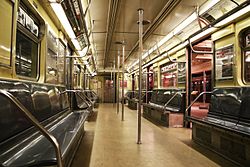R38 (New York City Subway car)
| R38 | |
|---|---|

An R38 train on the
|
|

Interior of an R38 car.
|
|
| In service | 1966-2009 |
| Manufacturer | St. Louis Car Company |
| Built at | St. Louis, Missouri, USA |
| Constructed | 1966–1967 |
| Entered service | August 23, 1966 |
| Refurbishment | 1987–1988 |
| Scrapped | 2008-2009 |
| Number built | 200 |
| Number preserved | 2 |
| Number scrapped | 198 |
| Formation | Married Pairs |
| Fleet numbers | 3950–4149 |
| Capacity | 50 (seated) |
| Operator(s) | New York City Subway |
| Specifications | |
| Car body construction | Stainless Steel sides with Carbon Steel chassis, roof and underbody, with fiberglass top front and top rear bonnets. |
| Car length | 60 ft (18.29 m) |
| Width | 10 ft (3.05 m) |
| Height | 12.08 ft (3.68 m) |
| Platform height | 3.76 ft (1.15 m) |
| Doors | 8 |
| Maximum speed | 55 mph (89 km/h) |
| Weight | 77,420 lb (35,117 kg) |
| Traction system | General Electric (GE) SCM 17KG192AE2/H7 propulsion system using General Electric (GE) 1257E1 (115 hp or 86 kW per axle) |
| Braking system(s) | WABCO E2 "SMEE" Braking System, A.S.F. simplex unit cylinder clasp (tread) brake |
| Track gauge | 4 ft 8 1⁄2 in (1,435 mm) |
The R38 was a New York City Subway car model built from 1966 to 1967 by the St. Louis Car Company in Missouri for the IND/BMT B Division.
The R38s were numbered 3950-4149. The cars were built to supply extra trains for the Chrystie Street Connection, which opened on November 27, 1967.
This was the second subway car order to be built with stainless steel exteriors. The cars were built with aluminum roofs, vandal-proof fiberglass seats, and with fluorescent lighting.
The cars were arranged in "married pairs" of two cars semi-permanently coupled together by a linkbar. Like the R32s before them, the R38s had body siding made of stainless steel. Even-numbered cars were known as "B" cars, while odd-numbered cars were known as "A" cars.
The R38 was the first subway car fleet to have air conditioning installed. The last ten cars delivered (4140–4149) came factory equipped with Stone Safety 10-ton split system air conditioning system featuring the compressor/condenser units mounted under the cars, and the evaporator units were installed on the top interior ends of same in 1967. The first six air conditioned cars came into service on July 19, 1967. The six-week experiment was a success after past failures and air conditioning would soon, but not immediately, become standard equipment on new rolling stock built for the system, since the first 200 R40 cars were built without air conditioning. The air conditioned cars cost $40,000 more than the non-air conditioned cars. From this point on, the New York City Transit Authority (NYCTA) began adopting air conditioning as standard equipment on all new cars, as well as some slightly older model cars retrofitted with same to make life much more bearable throughout the subway system. This Stone Safety Air Conditioning system was adopted from their standard railroad coach or commuter coach air conditioning systems used very successfully.
...
Wikipedia
